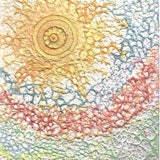Kintsugi is a traditional restoration technique of Japan.
I've been interested in trying it for a long time, but I thought it was a technology that used lacquer and had high hurdles.
This summer, the Kamakura Sculpture Museum was indebted to Enoden's "Mizutamaten" held in Kamakura. Kamakura carving experiences are held regularly, but they hold a kintsugi class once a month, so I applied without hesitation.
A pulp art plate made by transferring the texture of pulped paper to clay, the lid of the teapot that my mother liked and used, the ceramic teacup that my late master bought for me because it was a little chipped and I used it carefully with glue ...
Things that have been chipped or broken even if you use them carefully, and things that you want to repair when Kintsugi is made, are close to you.
In the monthly class, you can learn how to make useful tools for kintsugi, so it is very informative and fun.
While being impressed by the ideas of the people of the past, such as mixing lacquer and flour to glue the applied parts, I thought about the warm hearts of the ancient Japan people who cherish things.
The teacher told me that this would be what would happen if I did this, but I wanted to go this far, so I was in a little hurry to work on it, and it turned out to be a sure thing, so I reflected a little.
Calm down
Be polite
While enjoying the process of repairing
While cherishing the hearts of Japan, wabi-sabi
Show original text

![[Image1]Kintsugi is a traditional restoration technique of Japan.I've been interested in trying it for a lon](https://img-cooljapan.imgix.net/member_posts/image/91ed536b42d6496a8a1dd0fc54dc4dd932606e9a.jpg?w=330&h=330&fit=min&auto=format&q=70)
![[Image2]Kintsugi is a traditional restoration technique of Japan.I've been interested in trying it for a lon](https://img-cooljapan.imgix.net/member_posts/image/875f94ddc3acd2b2257e9716e7eb29776e3976d8.jpg?w=330&h=330&fit=min&auto=format&q=70)
![[Image3]Kintsugi is a traditional restoration technique of Japan.I've been interested in trying it for a lon](/img/dot.gif)

